Pendo vs Stonly vs Userpilot: Which is Best for Your SaaS?
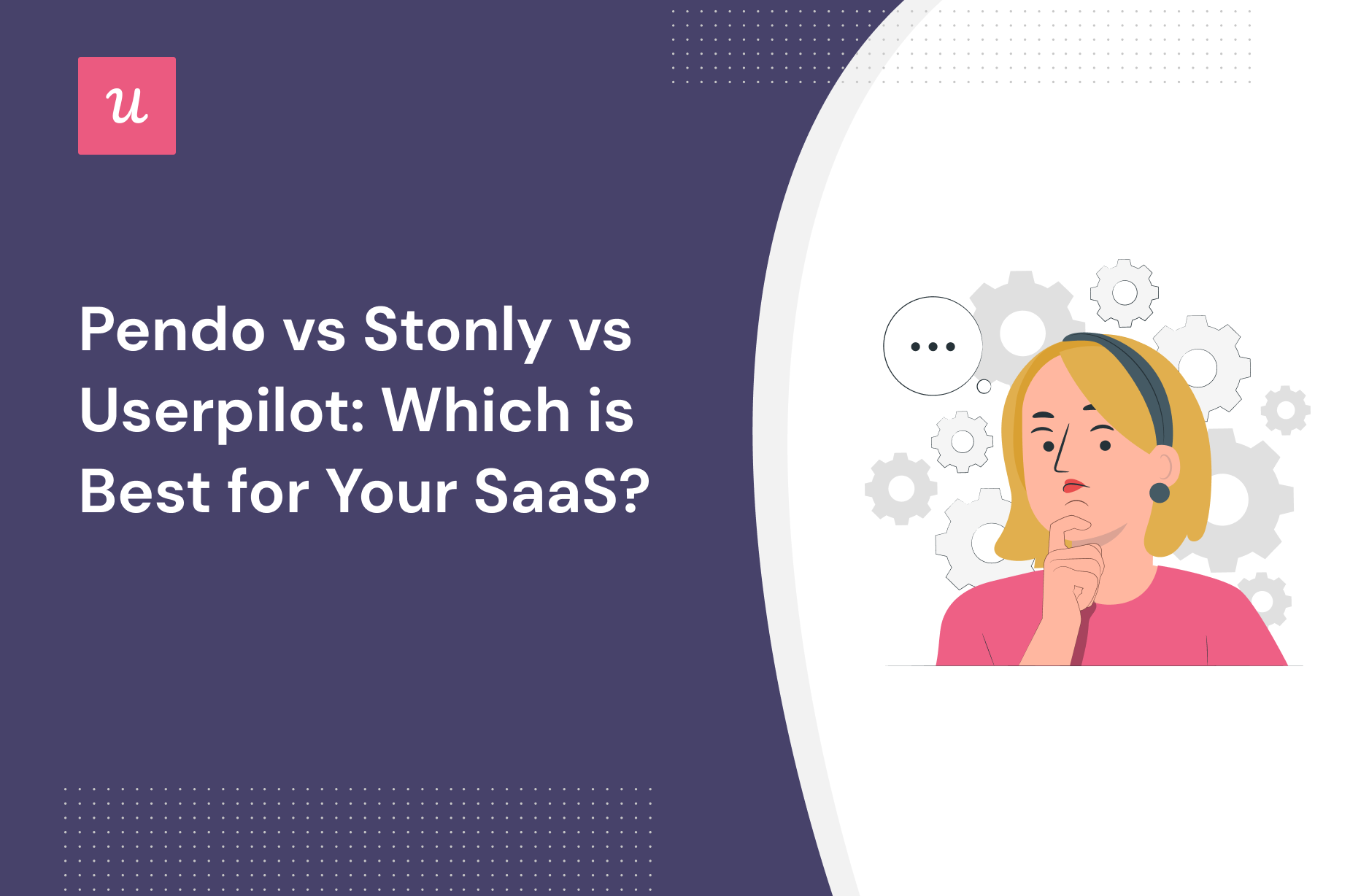
Deciding between Pendo, Stonly, and Userpilot? We know that choosing the best product adoption platform for your SaaS is difficult.
So we decided to write a more in-depth comparison of the three tools – going into more detail about the tools’ features, use cases, pros, and cons – than what you’ll find on review sites. Whether you’re looking mainly to improve your user onboarding or product analytics, collect user feedback, or NPS – you’ll find out how Pendo performs vs Stonly vs Userpilot – and which one is the best choice for you!
Let’s dig in!
TL;DR
- Pendo stands out as a robust digital adoption platform offering remarkable analytics, in-app feedback capabilities, and features for product adoption. Its target audience mainly consists of enterprise users, and it likely possesses the most advanced analytics among the tools discussed in this article. However, it’s important to note that such comprehensive features come with a corresponding cost.
- Stonly positions itself as a budget-friendly alternative to its more expensive competitors, but in fact – it’s more of a CS tool for building knowledge bases than a product adoption tool for onboarding. Similarly, as with Intercom Product Tours, Stonly’s tour builder feels like a makeshift add-on to the Knowledge Bases rather than a fully-fledged product (compared to its competitors like Userpilot or Appcues).
- Userpilot is a comprehensive digital adoption platform (DAP). It enables product teams to track product usage and user behavior to guide product development and optimize the user experience. In addition, it allows them to gather user feedback with various survey templates and design personalized onboarding experiences to drive product adoption. All of this is possible without coding. Book a demo to learn more.
![]()
Comparing Pendo vs Stonly vs Userpilot? Try the best one!

What is Pendo?
Pendo is a comprehensive digital adoption platform with impressive analytics, in-app feedback, and product adoption features.
It caters primarily to enterprise users and probably has the most advanced analytics of all tools we’re covering in this article. But it all comes at a price.
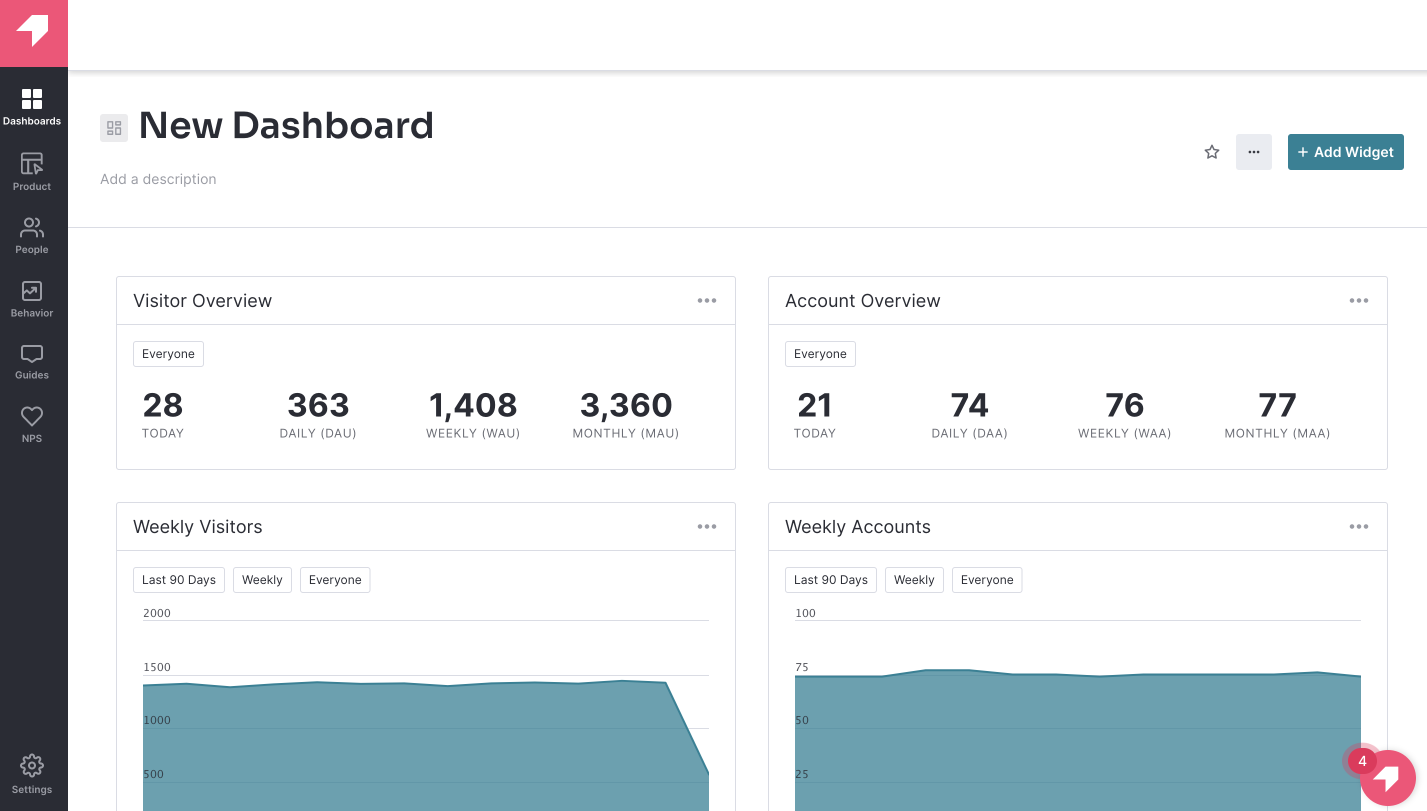
What is Pendo best for?
Typically, SaaS Product Managers consider Pendo for the following reasons: they want to improve their user onboarding, they need product adoption, and would also be able to measure their user feedback. How does Pendo perform when it comes to these top-three use cases? Let’s examine it all, and then compare it to the other tools we’re discussing in this post.
Pendo for user onboarding
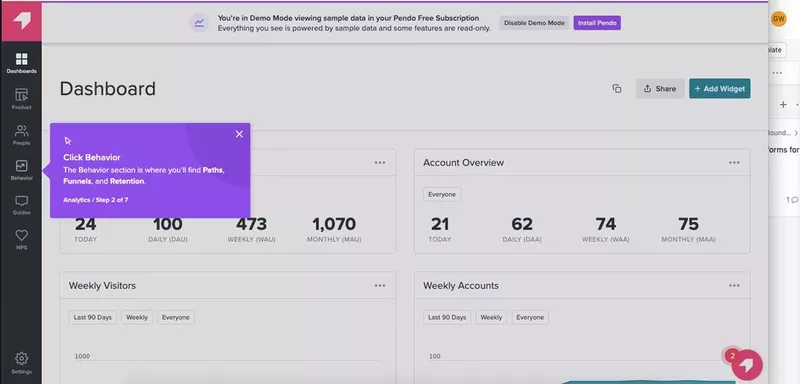
Pendo for user onboarding
When it comes to user onboarding, Pendo offers guides for building in-app guidance that improves user onboarding across the web and mobile apps. But how much do they cost, and are there better alternatives on the market?
Here’s what to expect from Pendo guides:
- You can build guides using templates, and there’s also a WYSIWYG (what-you-see-is-what-you-get) visual design studio editor for creating new designs from scratch.
- You can use Pendo’s free version to create user onboarding guides, but you’ll only get access to limited features and basic analytics.
- Types of guides you can create using Pendo include Lightbox, Banner, Tooltips, Polls, and Walkthroughs. The drawback with them is that they are quite basic and don’t allow much customization without coding. Even Pendo’s own onboarding guide is a series of purple tooltips.
- You can also build checklists with Pendo but not as standalone UI elements as users can only access them from the resource center (if they know they exit). This makes it hard and not intuitive for users to access guidance and overall defeats the purpose of using checklists.
- Pendo product guidance for mobile works across Android and iOS mobile apps, so if you’re looking to support your mobile customers through their onboarding, Pendo might be for you (be aware that Pendo for mobile guides is not included on the free plan).
Guides or product tours are essential tools for user onboarding, and it will be difficult for new users to find their way around your app without them. The absence of these UX designs will lead to friction, naturally resulting in increased churn.
But do you need Pendo for this?
The answer is you don’t have to use Pendo in particular. There are other product adoption tools that give you more value for your money, so it’s always good to check the available options before settling for one.
Pendo for product adoption
Pendo is a robust product adoption platform with user engagement features, impressive analytics, and in-app feedback.
Here’s how Pendo can help you improve product adoption: When it comes to product adoption, Pendo offers analytics features to track the adoption of features as well as a guide for building in-app guidance that improves feature adoption both on web and mobile apps.
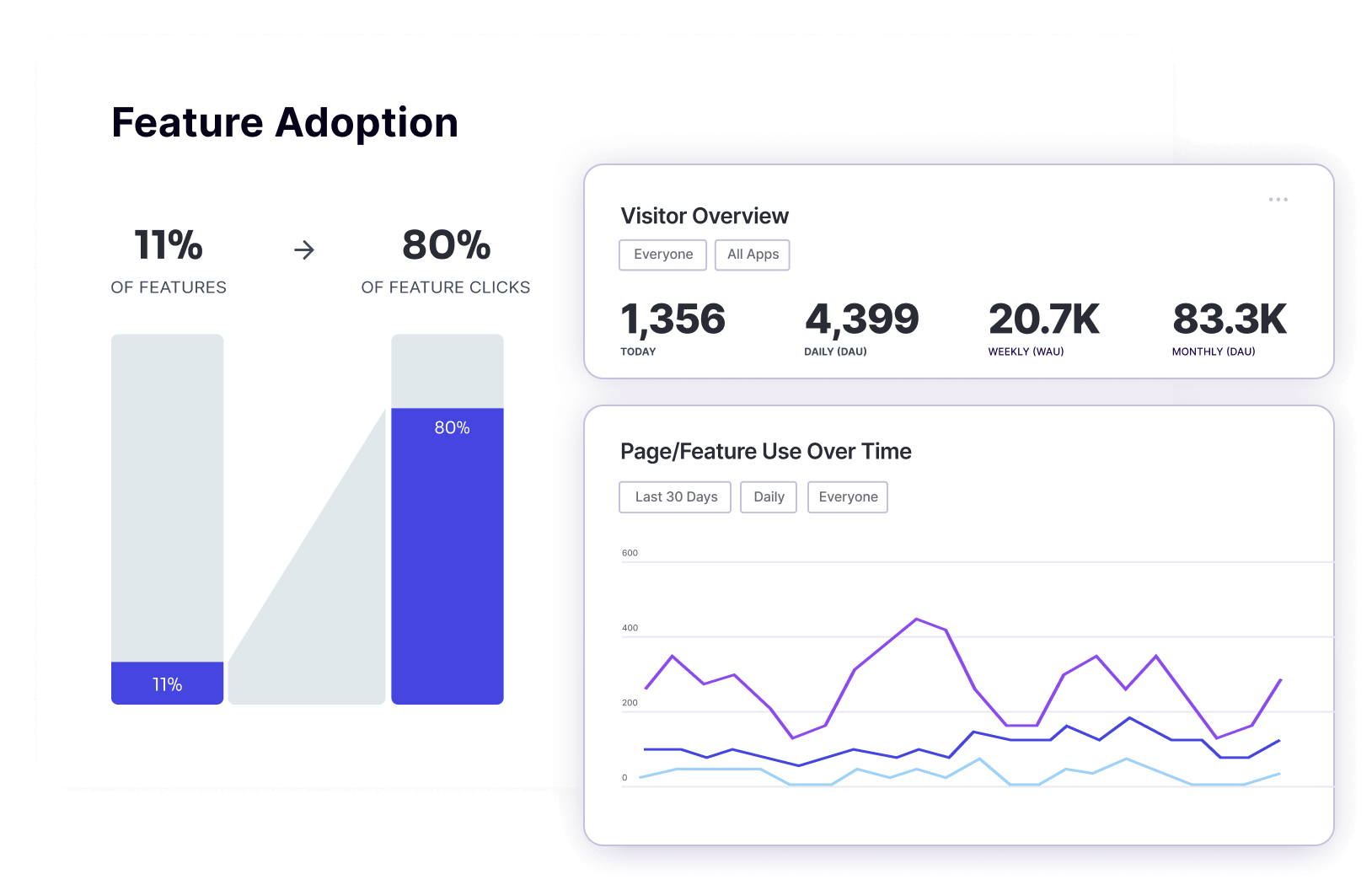
Pendo for product adoption
Here’s what to expect from Pendo’s product adoption features:
- Pendo’s analytics allow you to evaluate each feature usage and which features deliver the most value.
- You can see which features are underused for different user segments.
- You can then build guides to improve the adoption of these features.
- You can use Pendo’s free version to create guides, but you’ll only get access to limited features and basic analytics.
Pendo for user feedback
Pendo offers polls (also called micro surveys at Userpilot) through their guides which collect user feedback and gauge sentiment at different points in the user journey.
Polls come with basic functionality and are available on the free plan. However, if you want to collect user sentiment with NPS surveys, you’ll need a paid plan that doesn’t come cheap at all.
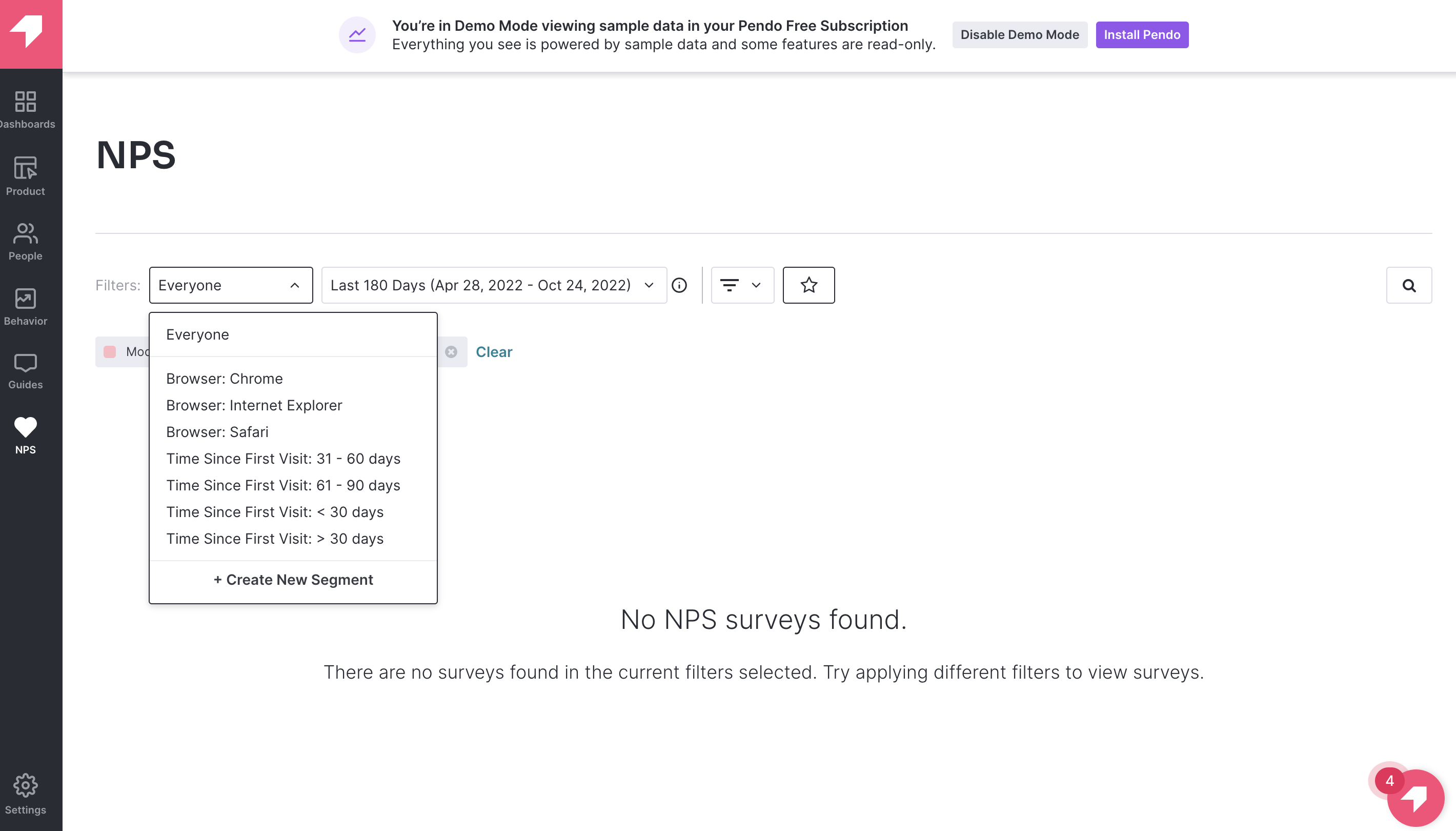
Pendo for user feedback
Here’s how you can collect user sentiment feedback with Pendo:
- Add short polls on your guides and UI patterns built with Pendo.
- You can use only text polls, yes/no polls, numbered scales, or multi-choice polls and add them as building blocks when building the guides.
- There’s not a lot of customization, like themes or emojis available, but it’s enough to collect data in-app.
- If you are willing to pay for the Growth plan, you get access to Pendo’s NPS feature too.
The downside of using Pendo for collecting user feedback is that you can’t use the insights to personalize the user experience. For example, you can’t create user segments based on NPS scores or specific answers you collect with your polls.
Considering the price you have to pay for Pendo, you’d expect more from it.
If you want to both collect and act on user feedback, you should use a better tool. And, with the risk of sounding biased, Userpilot gives you more value for money here. You can build micro surveys, embed Typeform long surveys, collect and analyze NPS responses, and segment users based on scores and responses so you can trigger more personalized experiences.
Get a Userpilot demo here.
![]()
There is a better tool for your SaaS than Pendo!

What is Stonly?
Stonly positions itself as a budget-friendly alternative to its more expensive competitors, but in fact – it’s more of a CS tool for building knowledge bases than a product adoption tool for onboarding. Similarly, as with Intercom Product Tours, Stonly’s tour builder feels like a makeshift add-on to the Knowledge Bases rather than a fully-fledged product (compared to its competitors like Userpilot or Appcues).
So it may be good for startups and small businesses with few users and a per-view pricing model (which may become super-expensive once you have more users!) and that want a tool primarily for the Knowledge Base use case.
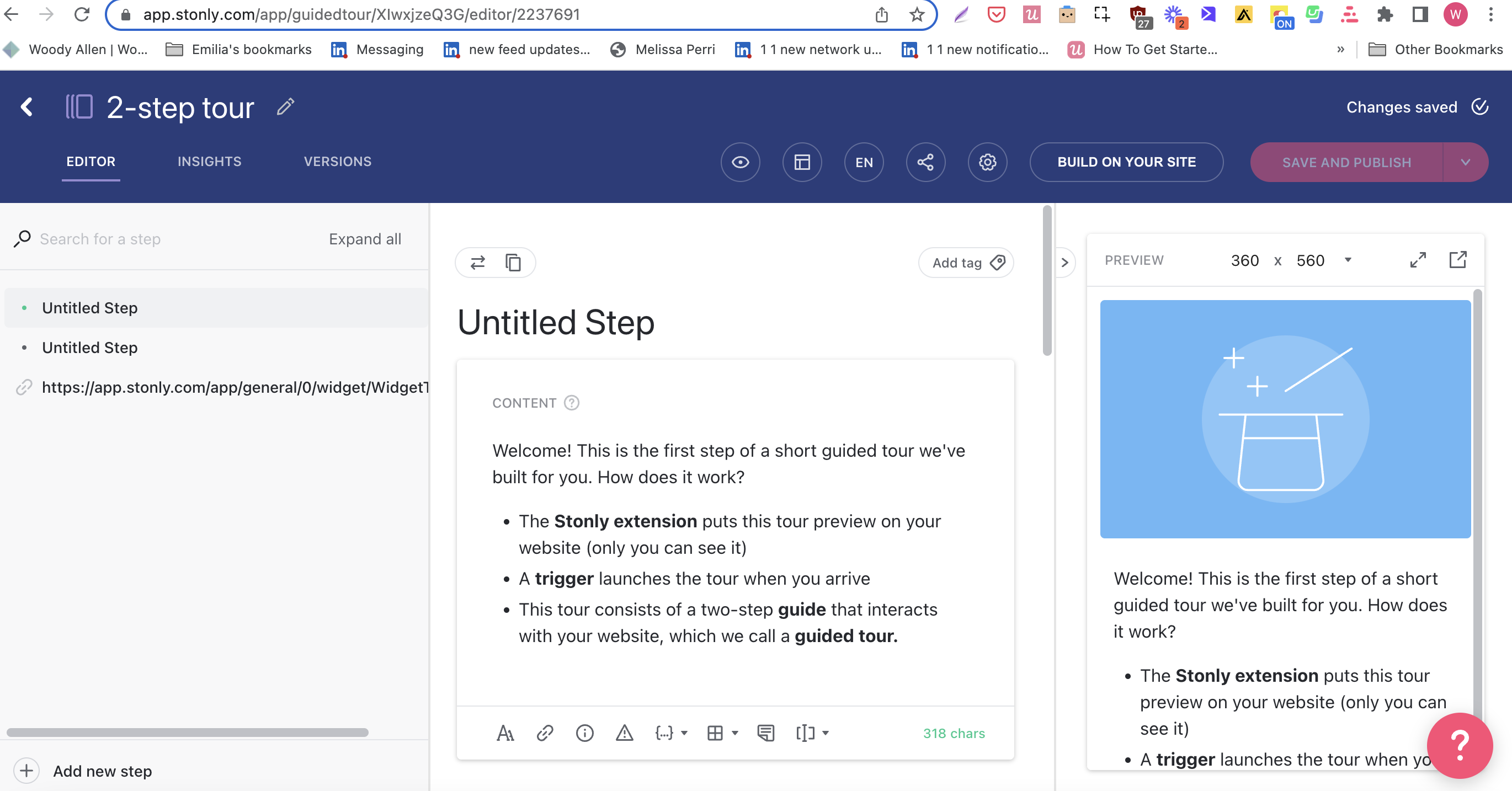
What is Stonly best for?
Similar to Pendo, Stonly is typically considered for user onboarding. Let’s examine Stonly for this use case before we compare it to Userpilot.
Stonly for user onboarding
Stonly’s product tours are not the most intuitive (and require quite a bit of coding), and they come with limited integrations. In fact – its setup and builder are extremely confusing: you can build the tours both in the Stonly dashboard and on top of your app, but then you need to go back to the dashboard to edit the content of the steps you’ve just built in the Chrome Extension. This doesn’t make much sense.
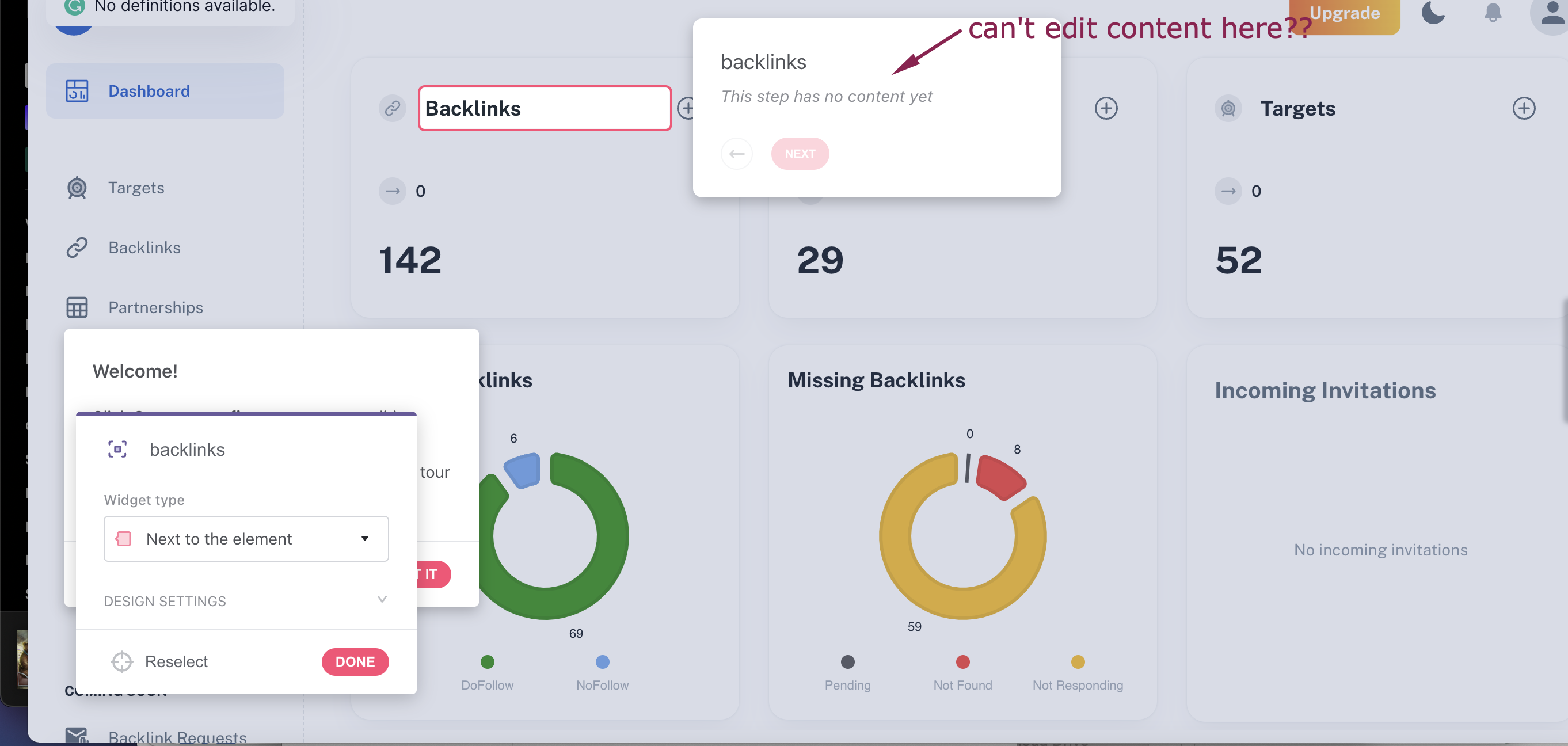
Stonly for user onboarding
![]()
Try a better tool for your SaaS than Stonly!

What is Userpilot?
Userpilot is a comprehensive digital adoption platform (DAP). It enables product teams to track product usage and user behavior to guide product development and optimize the user experience.
In addition, it allows them to gather user feedback and design personalized onboarding experiences to drive product adoption. All of this is possible without coding.

What is Userpilot best for?
Userpilot is used for similar use cases as Stonly and Pendo. Let’s see how Userpilot compares to the tools we discussed before it comes to user onboarding, product adoption, and user feedback.
Userpilot for user onboarding
Userpilot was built specifically for SaaS product teams that want to improve their user onboarding experience and boost user activation.
You can build a huge variety of user onboarding experiences and in-app guidance flows without needing to code.
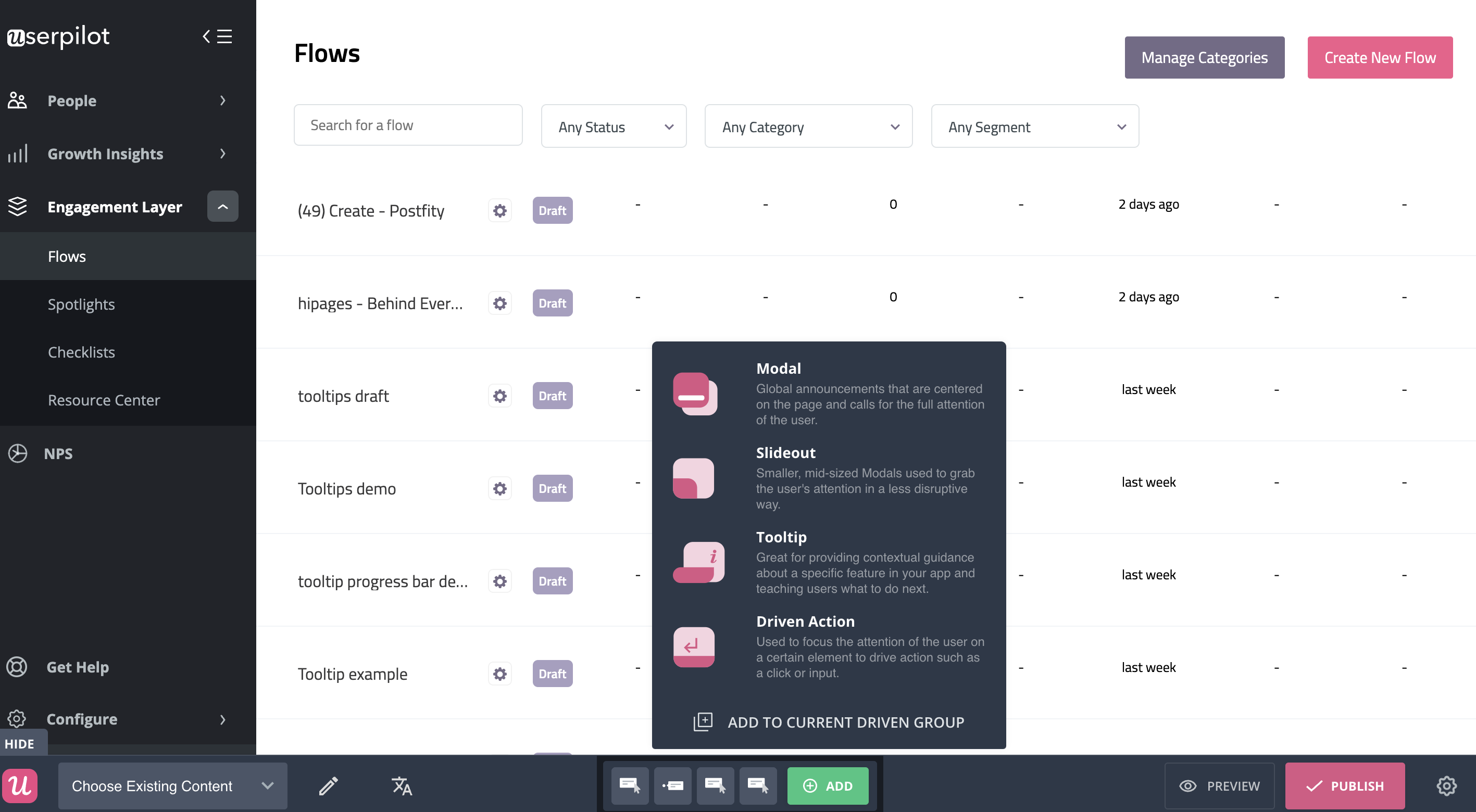
Userpilot for user onboarding
Here’s what you’ll get when you start using Userpilot:
- Forget about coding in-app experiences: Userpilot is a no-code solution and only requires your dev to install a line of javascript inside your app and for you to download a Chrome extension that opens up the visual builder.
- Build in-app flows using the largest range of UI patterns (modals, slideouts, tooltips, hotspots, banners) and in-app onboarding experiences (checklists, micro surveys, NPS surveys, in-app resource center).
- Get access to a built-in NPS tool for collecting and analyzing user sentiment so you can improve your onboarding process based on real data.
- Create and track combinations of in-app events like clicks, hovers, and form fills, and then analyze all these interactions under your own custom events, which can be built without code or API calls.
- Use advanced product analytics and in-app flows analytics to identify where users need help and create granular user segments to trigger in-app experiences contextually (segment based on user identification data, in-app engagement, custom events, clicks, hovers, form fills, user feedback responses, NPS scores and more).
- Enhance the onboarding experience with in-app help by launching a Resource Center directly inside your app. Add in-app guides, and video tutorials, and give users access to search the knowledge base or reach out to support. Self-service has never been easier.
The best user onboarding is contextual and it happens right where the users need it, inside your app. There isn’t a better user onboarding tool out there that offers more value for the money than Userpilot.
Schedule a demo with our team and get ready to build the best onboarding experiences your users have seen.
Userpilot for product adoption
Product adoption describes the process of getting users to the point where they are experiencing value from your product.
Userpilot is a powerful product adoption platform that enables you to quickly build personalized and contextual in-app experiences targeted to different user experiences – all without writing a line of code.
It’s a great option for enterprise users too since it’s SOC 2 Type II certified and offers robust features for large-scale usage.
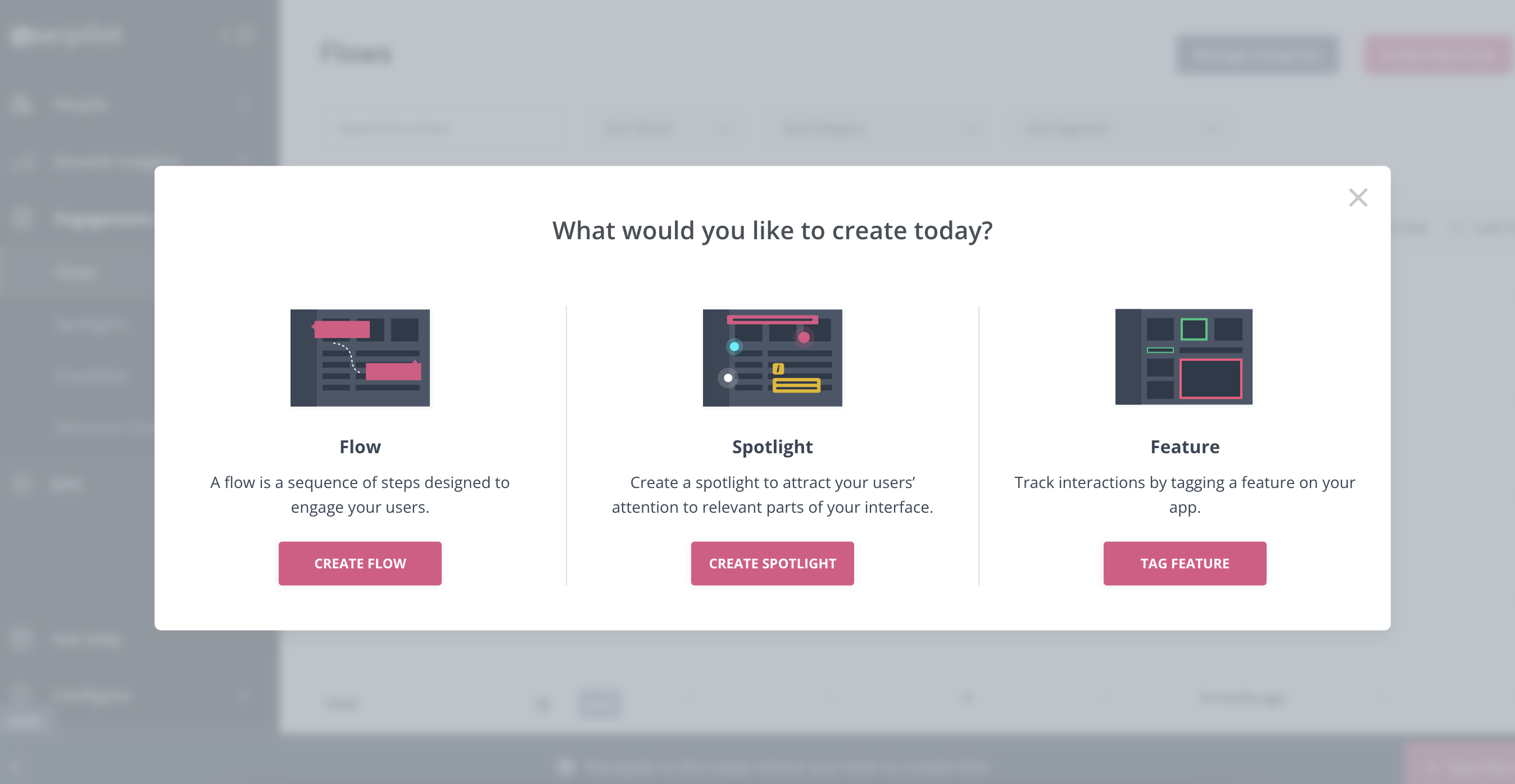
Userpilot for product adoption
Here are some of Userpilot’s product adoption features that you may find helpful:
- A broad range of UI patterns to build fully customizable, contextual, and interactive in-app flows: modals, slideouts, tooltips, hotspots, driven actions, banners, and more. And – most importantly – you are not limited by plan when it comes to how many UI patterns or designs you can build.
- Advanced in-app checklists with built-in gamification elements like progress bars or ”automatically marked complete” tasks: checklists also come with analytics so you can track who is interacting with them and how.
- Fully interactive walkthroughs walk users through engaging and adopting specific features of your app.
- The self-service in-app resource center lets users search your knowledge base directly inside the app, access chat, and support but also launch guides and tutorials when they get stuck.
- User feedback tools allow you to collect insights to improve the product and the user experience, thus leading to a higher product adoption rate. You can also collect NPS data and tag responses to uncover patterns into what makes users stick, or build micro surveys for more granular data. Then you can use all the feedback collected to build user segments based on the answers and personalize the path to higher product adoption for each segment.
Want to see Userpilot in action? Get a demo and improve product adoption with contextual and personalized in-app flows that actually help users.
Userpilot for user feedback
There are two types of feedback you should be focusing on collecting to better understand the health of your product and users.
First, you have user sentiment which looks at user satisfaction and effort scores or loyalty (using NPS surveys). Then you may also want to collect feedback on the functionality of the product or specific features.
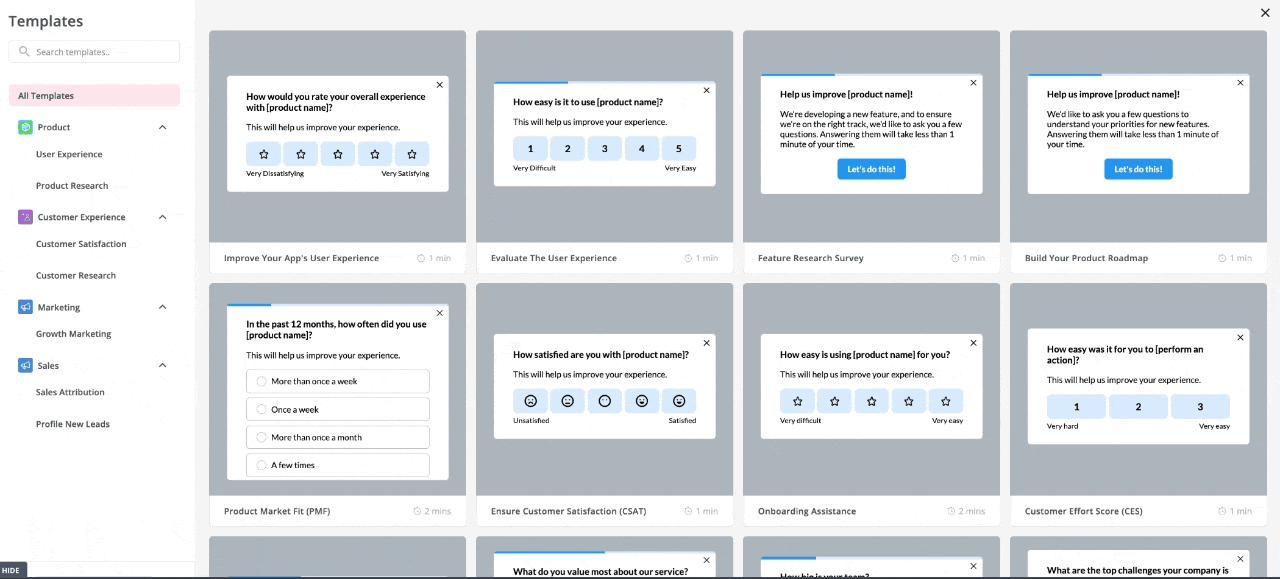
Userpilot for user feedback
You can do all these with Userpilot. In short, you can:
- Collect and track (NPS) in-app with a built-in NPS widget that allows you to fully customize the survey look and feel, and set the trigger frequency and specific targeting.
- Analyze NPS scores, tag responses, and use the data to create specific user segments.
- Build and trigger in-app micro surveys like the classic PMF survey, or similar ones and mix multi-choice and open-ended types of questions to collect specific insights.
- Be in charge of who gets which survey type and when with advanced segmentation capabilities, and of course, you can use the answers to segment your audience.
The advantage of using Userpilot for collecting feedback over other survey tools is that you can better control who sees the surveys but also you can instantly use the data collected to segment your user base and trigger the right experience for them.
For instance, if your users give you a low NPS score because they think you’re missing a critical feature (that you actually have already), you can push an interactive walkthrough guiding them to find and explore this feature.
![]()
Tired of bad digital adoption tools? Try Userpilot for your SaaS!

Which tool should you choose?
As you can see, Pendo, Stonly, and Userpilot cater to most of the use cases Product Managers typically look for in their SaaS companies. There are some differences between the tools when it comes to how those use cases are executed in each, of course. So if you’re still on the fence – there are two more factors that can make a difference for you – the tools’ pricing, and its reviews. Let’s have a look at both below!
Pendo pricing
Pendo’s pricing is only available to you if you ask for a quote. The company doesn’t list pricing on its site for the higher tiers. However, some reviews say they have prices starting at $20,000-$25,000 per year for a single product, and around $50,000 per year for the mid-tier package.

Pendo pricing
The tricky part when it comes to Pendo’s pricing is that you get to pay separately for different modules:
- Pendo Free: Up to 500 MAUs, single-app, and basic functionality and analytics.
- Pendo Starter – $7,000/year: 2,000 MAU limit, multi-app, and access to premium features like NPS but it doesn’t include advanced analytics or integrations.
- Pendo Growth: Custom MAU, single-app, NPS and PES, resource center, and access to support compared to lower plans.
- Pendo Portfolio: Custom MAU, multi-app, cross-journey reports, experimentation, and 1 free integration included.
- Pendo Feedback: Collecting feature requests is a separate module with custom pricing.
- Pendo Adopt: Employee onboarding is a separate module with custom pricing.
- Pendo Integrations: Synchronizing Pendo with your integrations is a separate module with custom pricing.
Stonly pricing
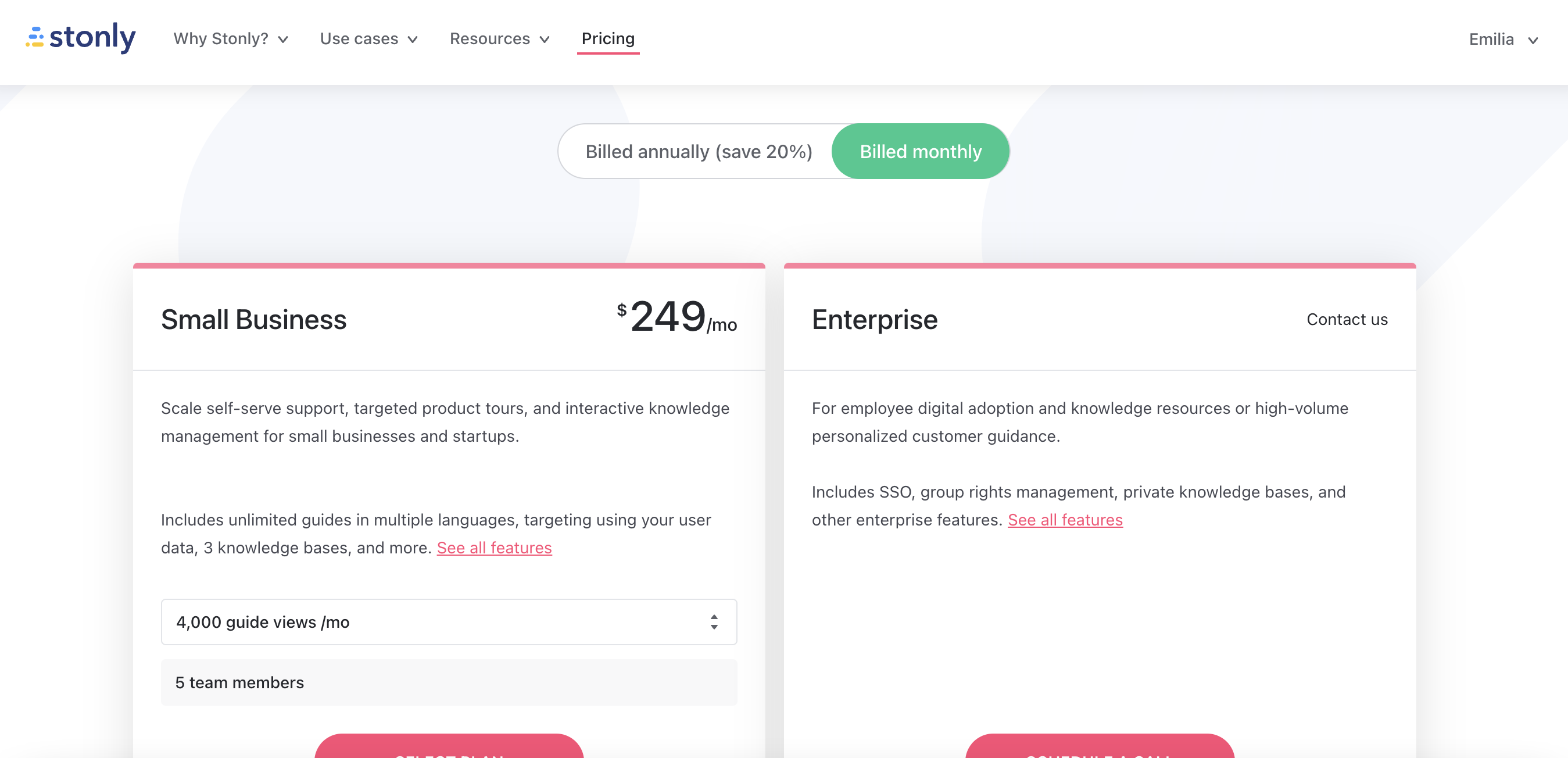
Stonly pricing
Stonly offers two main pricing plans for its customers, catering to different business sizes and needs. The pricing details are as follows:
- Small Business: Billed at $199/mo, this plan is designed for small businesses and startups looking to scale self-serve support, targeted product tours, and interactive knowledge management. Features include:
- Unlimited guides in multiple languages.
- Targeting using your user data.
- 3 knowledge bases.
- 4,000 guide views per month.
- 5 team members.
- Enterprise: Pricing is available upon contacting Stonly, this plan is geared towards employee digital adoption and knowledge resources or high-volume personalized customer guidance. Features include:
- SSO (Single Sign-On).
- Group rights management.
- Private knowledge bases.
- Other enterprise features.
Customers can save 20% on both plans when billed annually.
Userpilot pricing
Userpilot’s transparent pricing ranges from $249/month on the entry-level end to an Enterprise tier for larger companies.
Furthermore, Userpilot’s entry-level plan includes access to all UI patterns and should include everything that most mid-market SaaS businesses need to get started.

Userpilot has three paid plans to choose from:
- Starter: The entry-level Starter plan starts at $249/month and includes features like segmentation, product analytics, reporting, user engagement, NPS feedback, and customization.
- Growth: The Growth plan starts at $749/month and includes features like resource centers, advanced event-based triggers, unlimited feature tagging, AI-powered content localization, EU hosting options, and a dedicated customer success manager.
- Enterprise: The Enterprise plan uses custom pricing and includes all the features from Starter + Growth plus custom roles/permissions, access to premium integrations, priority support, custom contract, SLA, SAML SSO, activity logs, security audit, and compliance (SOC 2/GDPR).
What users say about Pendo Stonly & Userpilot
Pendo reviews
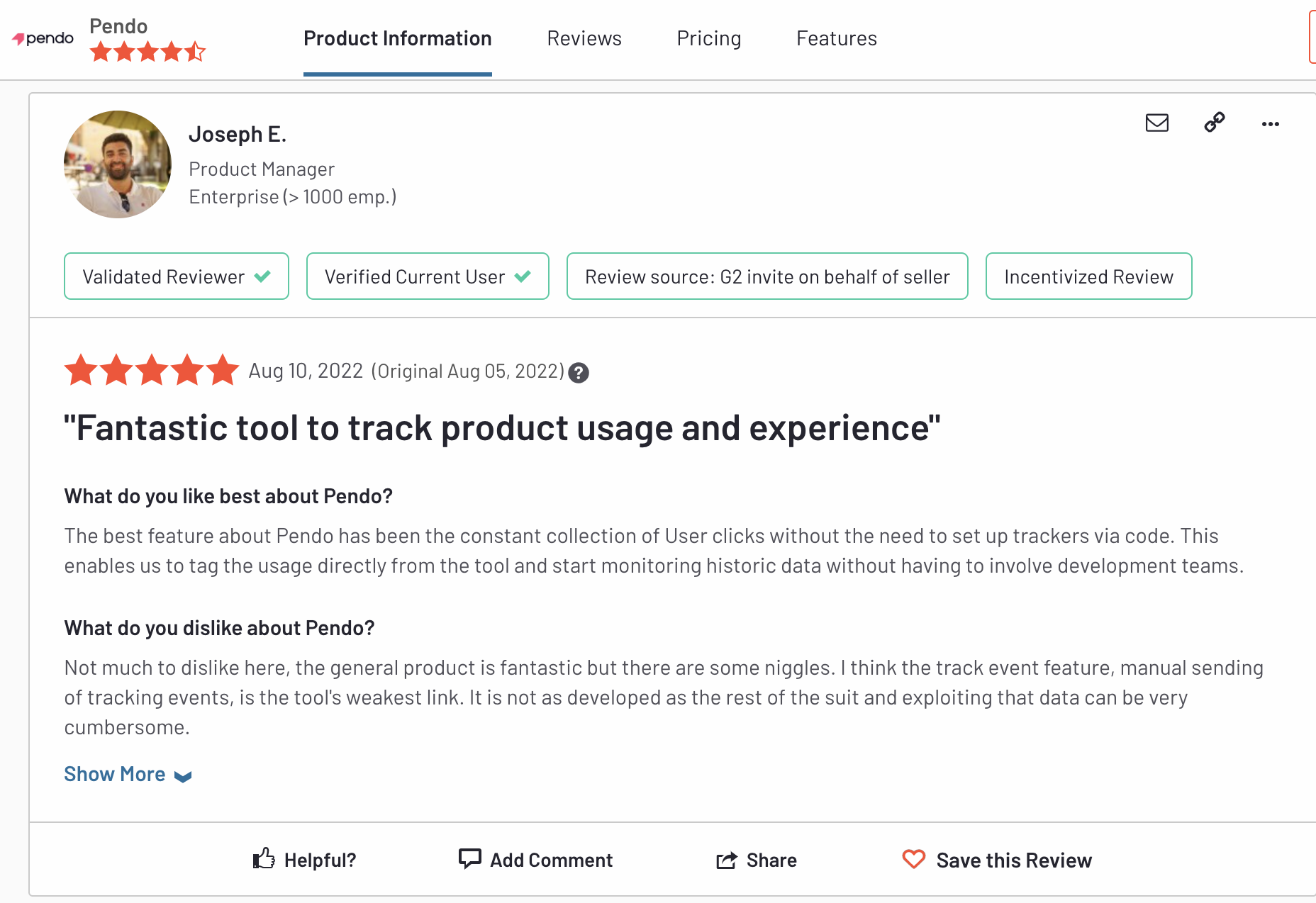
Pendo review
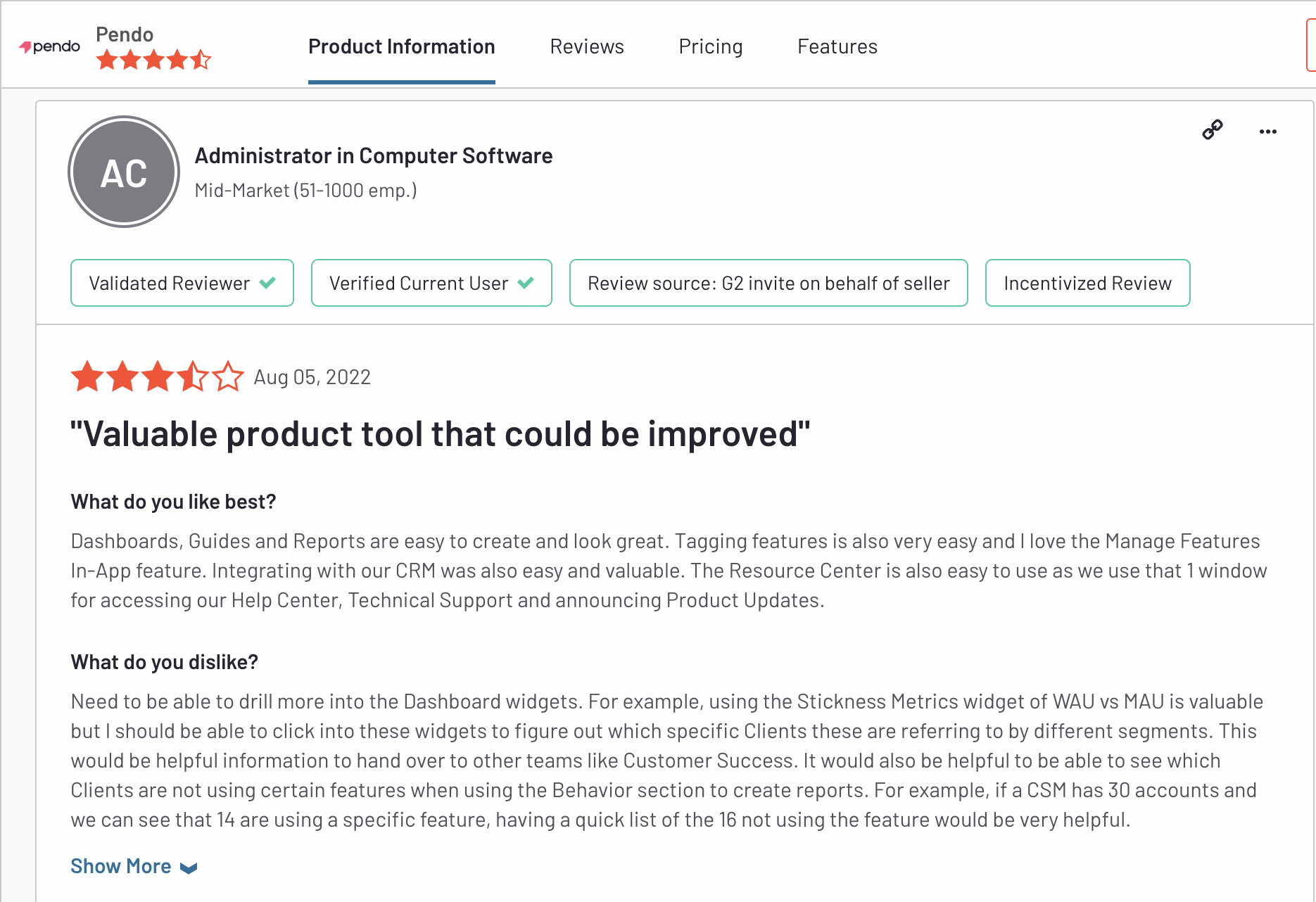
Stonly reviews
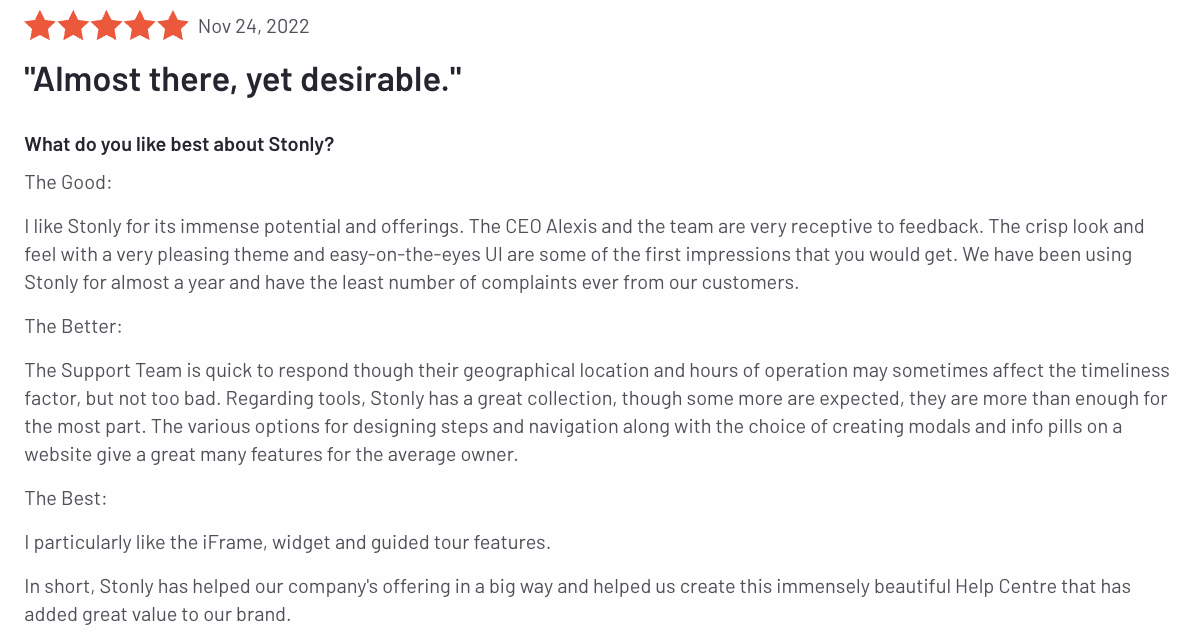
Stonly review
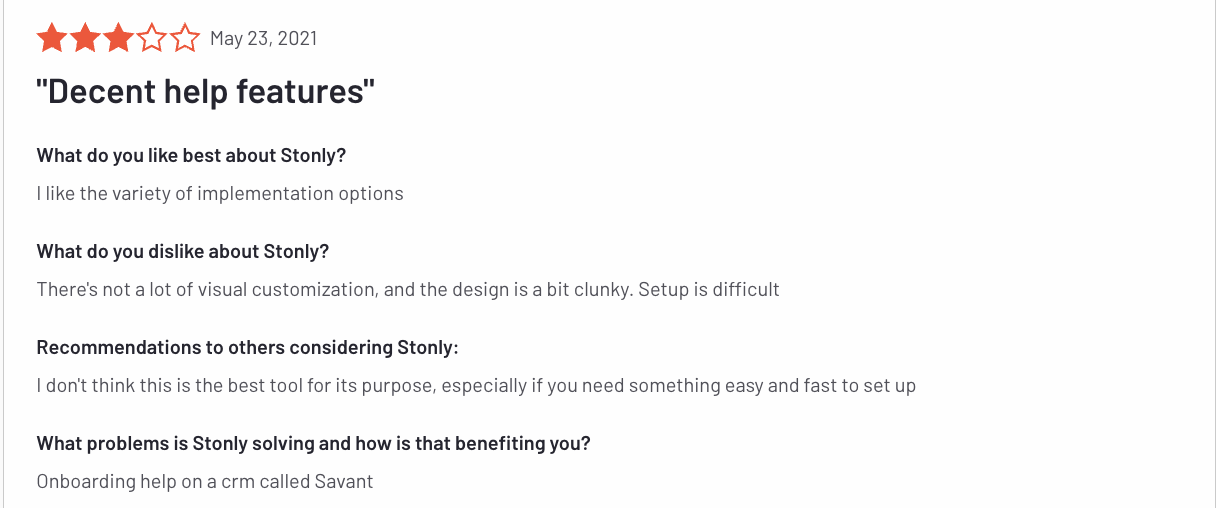
Stonly review
Userpilot reviews

Userpilot review.
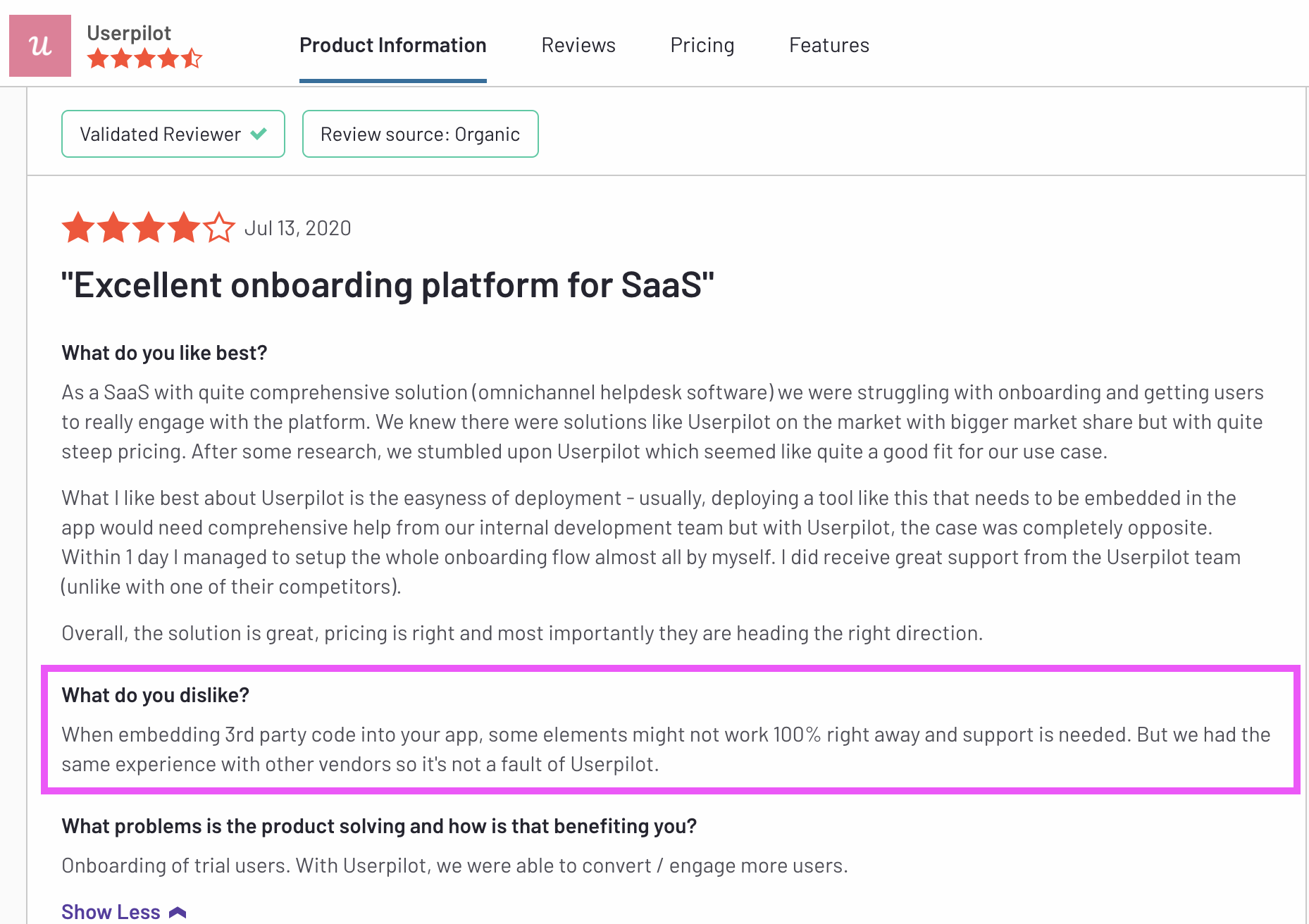
Userpilot review.
Pros & Cons of Pendo, Stonly and Userpilot
Pendo pros
Despite the price and its steep learning curve, Pendo does have a few pros compared to its competitors.
- Pendo is known for its good and easy-to-use analytics tools like Paths, Retention, and Funnels (coming soon in Userpilot).
- Pendo has a shareable product-planning tool to organize customer feedback and prioritize high-value features. It helps keep teams aligned with the shared feature-planning guide.
- It works on web apps and mobile apps so if you need both, this might be a good choice for you.
Pendo cons
Surprisingly for a product engagement tool that claims to be “all in one” you can’t act directly on the user analytics from Pendo in Pendo.
That’s because Pendo doesn’t allow you to target users segmented by in-app events with the in-app guides you’ve built with it.
Here’s a short list of Pendo’s cons:
- It doesn’t allow you to trigger experiences based on in-app events either. This is probably because of tech debt – but makes Pendo’s analytics pretty much NOT actionable.
- Pendo offers limited onboarding elements, which means you can’t always create the best experience for your users. If you want checklists these can only be accessed from the Resource Center which defeats the purpose of having them in the first place.
- User behavior data is displayed with a 1-hour delay. As a result, you can’t trigger contextual in-app messages or guidance in response to what users do.
- Pendo’s pricing, other than the Starter plan, is only available to you if you ask for a quote. The company doesn’t list pricing on its site for the higher tiers. However, some reviews say they have prices starting at $20,000-$25,000 per year for a single product, and around $50,000 per year for the mid-tier package. This might be Pendo’s biggest downside.
If you’re looking for a tool that shows you user analytics in real-time and allows you to trigger in-app experiences based on in-app events and user behavior in real-time – Userpilot offers these features (and at a lower price tag too).
Stonly pros
Stonly has a number of advantages:
-
The ability to support multiple languages.
-
Small companies with fewer initial views will benefit from this pricing model.
-
Integrated analytics.
-
Front, Zendesk, Freshdesk, and Segment integrations.
-
Knowledge base functionality included.
Stonly cons
There are also several considerable downsides to using Stonly though:
- Extremely confusing builder
- Pretty code-heavy product tour setup for a “no-code tool”
- Confusing installation: it’s impossible to install it for a non-technical user:
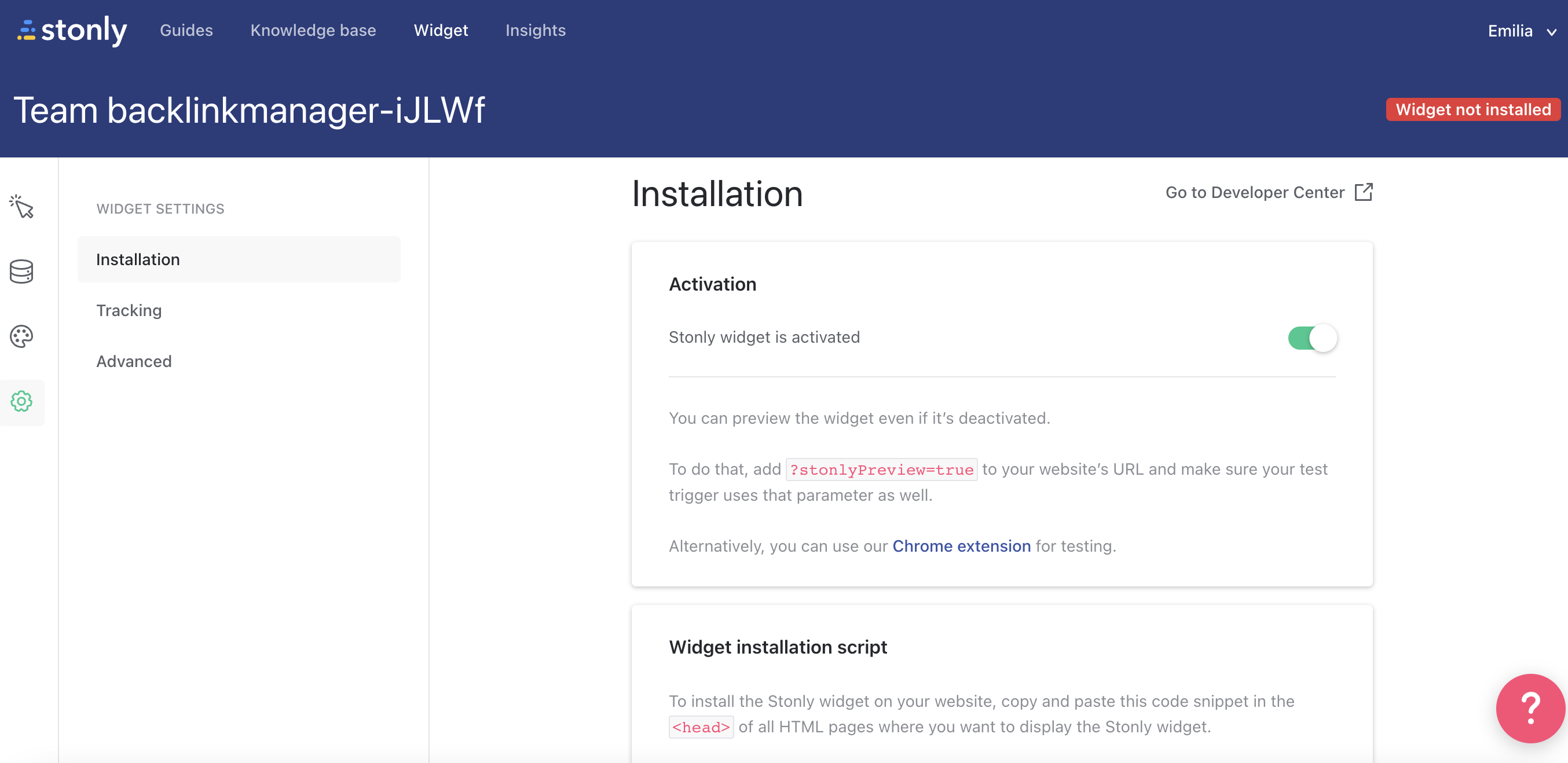
-
Requires some knowledge of CSS to customize – the customization options are worse than the market standard.
- Doesn’t allow you to add content to your product guides (text) directly in the Chrome Extension:
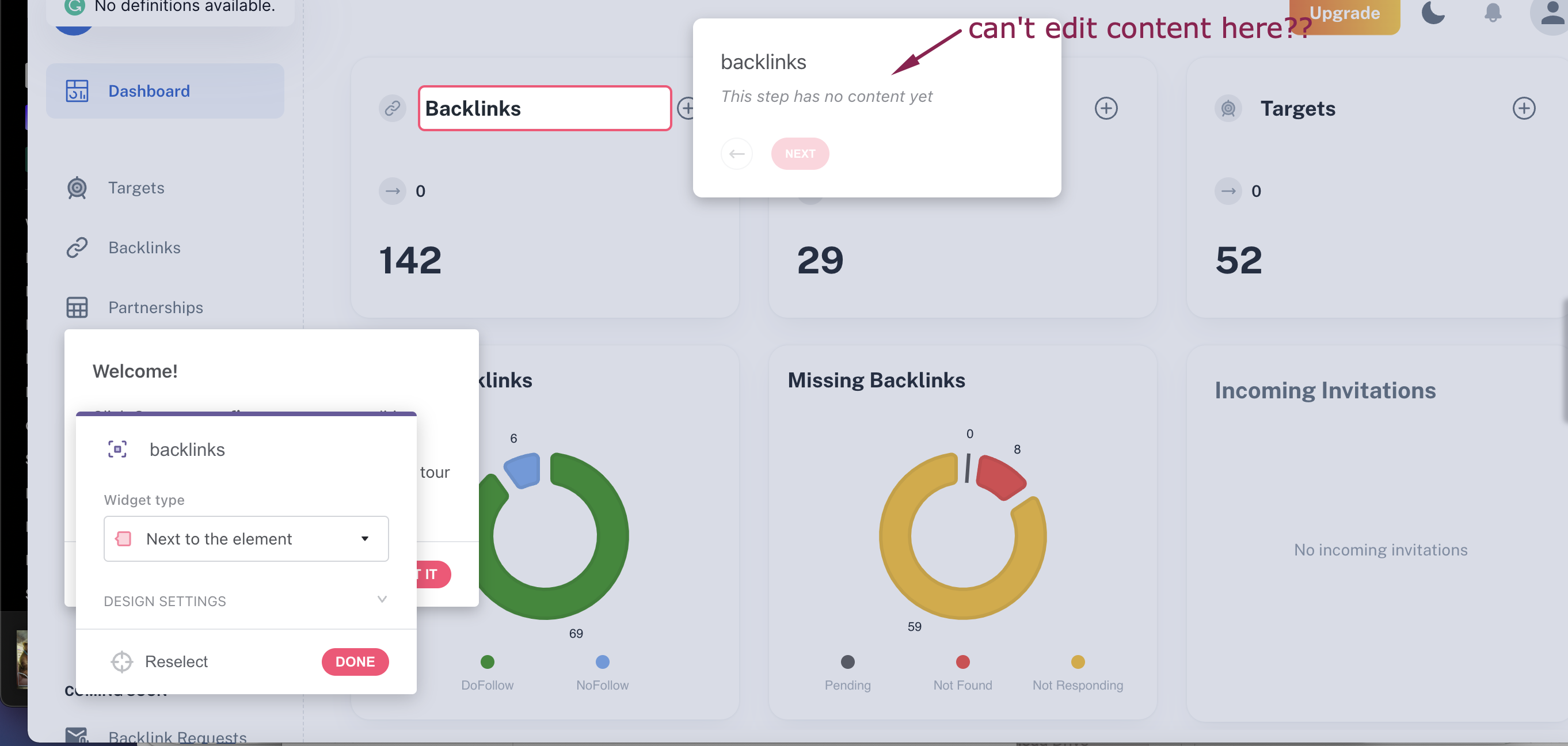
-
There is a lack of certain popular product tour features, such as progress bars and checklists
Userpilot pros
Userpilot has a number of advantages, especially for mid-market SaaS companies looking for a robust but at the same time very easy-to-use, no-code tool for user onboarding, product adoption, and simplified product analytics. Let’s have a look at the pros of using Userpilot:
- No-code builder – Userpilot comes with an easy-to-use Chrome Extension builder.
- Multiple UI patterns – choose from a range of options to build customized flows: modals, slideouts, banners, tooltips, hotspots, and checklists are all at your disposal
- UI patterns are not limited by plan – you get access to all of them on every single plan, meaning you get value even with the Traction plan (this is the entry-level one).
- Engaging walkthroughs and onboarding flows- build interactive walkthroughs targeted to distinct user segments.
- In-app help – build a resource center offering self-service support to your users, customize it with your branding, and select from a range of help options to boost user satisfaction (i.e. videos, in-app flows, chat, and more).
- Experimentation – built-in A/B testing for flows lets you explore and quickly iterate based on direct user behavior.
- Powerful feedback options- integrated NPS surveys with analytics and response tagging unlock insight into how your users feel.
- Advanced analytics and segmentation- analyze product usage and in-app flow engagement and build user segments using the data.
- Event tracking and feature tags- tag UI engagement (clicks, form fills, hovers) and group them into one custom event to track what really matters.
- More value with integrations- unlock value faster with built-in integrations with popular tools like Segment, Amplitude, Mixpanel, Kissmetrics, Intercom, Heap, and more.
Userpilot cons
There are, however, some downsides to Userpilot as well:
- Browser/web app only – Userpilot won’t run on mobile devices/applications.
- Doesn’t support employee onboarding- The tool is better suited for customer onboarding than for employee onboarding as you can’t build in-app guides on third-party tools.
- Missing integrations – doesn’t have built-in integrations with some tools, but it has webhooks, and Hubspot and Zapier are coming soon.
- Not appropriate for small startups on a shoestring budget (<$100)- Userpilot is a powerful, mid-market to enterprise-level tool. So $249 a month might be too expensive for really small startups.
![]()
Try the best tool for user onboarding!

Conclusion
In this post, we’ve discussed how Pendo, Stonly, and Userpilot compare when it comes to user onboarding, product adoption, and user feedback. We’ve discussed their features for each use case, pricing, reviews, as well as the pros and cons. Hopefully, you’ve found these detailed descriptions helpful. Obviously, we’re a little biased, but we think that Userpilot offers the best value for money, and is unrivalled especially when it comes to user onboarding. Hopefully you’d like to give Userpilot a chance – see you in the demo soon!

